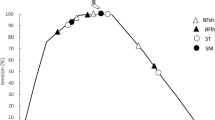Abstract
The purpose of this study was to determine force-length relations of selected human skeletal muscles, based on the theoretical foundations of the cross-bridge model and to calculate a strength curve for knee extension from these relations. Force-length relations were determined for the rectus femoris, vastus lateralis, vastus medialis, vastus intermedius and gastrocnemius muscles, using sarcomere/ fiber length data form both legs of four cadavers and sarcomere geometry data reported in the literature. It appears that the two-joint muscles investigated in this study are not able to produce force throughout their full anatomical range of motion, whereas the one-joint muscles can. The strength curve for knee extension was determined as the sum of the force-length relations of the individual knee extensor muscles and showed good agreement with experimentally obtained knee extensor strength curves.
Similar content being viewed by others
References
Abrahamse SK, Herzog W, and ter Keurs HEDJ (1988) Considerations regarding force-length relations of human rectus femoris muscle. Proceedings of the Canadian Society for Biomechanics Ottawa, pp 30–31
Blix M (1891) Die Laenge und die Spannung des Muskels. Scand Arch Physiol 3: 295–318
Campney HK, Wehr RW (1965) An interpretation of the strength differences associated with varying angles of pull. Res Q 36: 403–412
Carpenter A (1938) A study of the angles in the measurement of the leg lift. Res Q 9: 70–72
Clarke HH, Elkins EC, Martin GM, Wakim KG (1950) Application of muscle power to movements of the joints. Arch Phys Med Rehabil 31: 81–89
Fick R (1910) Handbuch der Anatomie des Menschen, vol 2. Fischer, Stuttgart
Gordon AM, Huxley AF, Julian FJ (1966) The variation in isometric tension with sarcomere length in vertebrate muscle fibers. J Physiol (London) 184: 170–192
Grieve DW, Pheasant S, Cavanagh PR (1978) Prediction of gastrocnemius length from knee and ankle posture. Biomechanics VI-A. University Park Press, Baltimore, pp 405–412
Herzog W (1985) Individual muscle force prediction in athletic movements. Thesis, University of Calgary Printing
Herzog W (1987) Determination of muscle model parameters using an optimization technique. Biomechanics X-B, pp 1175–1179
Herzog W, ter Keurs HEDJ (1988) Force-length relation of in-vivo human rectus femoris muscles. Pflügers Arch 411: 642–647
Hill AV (1938) The heat of shortening and the dynamic constants of muscle. Proc R Soc Lond Biol 126: 136–195
Huxley AF (1957) Muscle structure and theories of contraction. Prog Biophys Biophys Chem 7: 255–318
Iwazumi T (1978) Molecular mechanism of muscle contraction: another view. In: Baan J, Nordergraaf A, Baines J (eds) Cardivascular system dynamics. MIT Press, Cambridge, Mass, pp 11–21
Kulig K, Andrews JG, Hay JG (1984) Human strength curves. Exercise and sport sciences reviews, vol 12. The Collamore Press, Lexington, pp 417–466
Lindahl O, Movin A, Rindgrist I (1969) Knee extension measurement of the isometric force in different positions of the knee joint. Acta Orthop Scand 40: 79–85
Steindler A (1977) Kinesiology of the human body. Thomas, Springfield
Wagemans E, Leemputte M van, Willems E (1988) An ultrasound method to determine muscle structure. Proceedings of the American Society of Biomechanics, 12th Annual Meeting, pp 208–209
Walker SM, Randolph-Schrodt G (1973) I-segment lengths and thin filament periods in skeletal muscle fibers of the Rhesus monkey and the human. Anat Rec 178: 63–82
Wickiewicz TL, Roy RR, Powell PL, Edgerton VR (1983) Muscle architecture of the human lower limb. Clin Orthop 179: 275–283
Wilkie DR (1968) Studies in biology 11. Muscle. Arnold London
Williams M, Stutzmann L (1959) Strength variation through the range of joint motion. Phys Ther 39: 145–152
Author information
Authors and Affiliations
Rights and permissions
About this article
Cite this article
Herzog, W., Abrahamse, S.K. & ter Keurs, H.E.D.J. Theoretical determination of force-length relations of intact human skeletal muscles using the cross-bridge model. Pflügers Arch 416, 113–119 (1990). https://doi.org/10.1007/BF00370231
Received:
Revised:
Accepted:
Issue Date:
DOI: https://doi.org/10.1007/BF00370231




